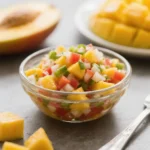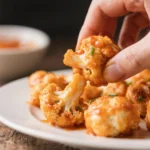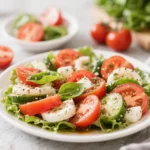Introduction
Mango salsa is a vibrant, tropical condiment that bursts with sweet, tangy, and spicy flavors. Originating from Latin American cuisine, it has become a global favorite due to its refreshing taste and versatility. Whether served alongside grilled fish, chicken tacos, or simply enjoyed with tortilla chips, mango salsa adds a zesty kick that elevates any meal. Its bright color and fresh ingredients make it not only delicious but also visually appealing—a true celebration of summer on a plate.
The beauty of mango salsa lies in its simplicity and adaptability. With just a few key ingredients, you can create a restaurant-quality accompaniment at home in under 20 minutes. Unlike traditional tomato-based salsas, mango salsa features ripe mango as the star ingredient, lending a luscious sweetness balanced by acidity and heat. It’s perfect for backyard barbecues, healthy snacking, or adding a pop of flavor to your weekly meal prep. This guide will walk you through everything you need to know about crafting the perfect mango salsa—from its rich history to expert tips, nutritional benefits, and creative variations.
The History
Mango salsa, while now considered a modern culinary staple, has roots that span across continents and cultures. The concept of combining fruit with savory elements can be traced back to ancient Mesoamerican civilizations such as the Aztecs and Mayans, who often paired tropical fruits with chili peppers, lime, and salt. These early forms of fruit-based relishes were used to complement game meats and maize-based dishes.
However, the specific iteration known today as mango salsa evolved more recently, particularly during the 20th century, as global trade introduced mangoes—native to South Asia—to Latin America. Mexico, in particular, embraced the mango and began incorporating it into traditional salsas, drawing inspiration from both indigenous practices and Spanish influences. Over time, chefs and home cooks experimented with blending the sweetness of mango with the sharpness of citrus, the crunch of vegetables, and the heat of chilies.
In the United States, mango salsa gained popularity in the 1980s and 1990s with the rise of fusion cuisine and the growing appreciation for bold, fresh flavors. It became a signature component of Baja-style seafood dishes, especially fish tacos. Today, mango salsa is celebrated worldwide, appearing in gourmet restaurants, food trucks, and kitchen tables alike. Its evolution reflects a beautiful blend of cultural exchange, seasonal eating, and the universal love for vibrant, flavorful food.
Ingredients Breakdown
The magic of mango salsa comes from a harmonious balance of sweet, sour, spicy, and savory components. Each ingredient plays a crucial role in building layers of flavor and texture:
- Ripe Mangoes: The foundation of the salsa. Choose Alphonso, Ataulfo (Honey), or Tommy Atkins mangoes for their creamy texture and natural sweetness. Ripe mangoes should yield slightly to gentle pressure and emit a fruity aroma near the stem.
- Red Bell Pepper: Adds a crisp texture and mild sweetness without overpowering the mango. It also contributes vibrant color.
- Red Onion: Provides a sharp, pungent bite that balances the sweetness. Soaking it in cold water for 5–10 minutes before use reduces its intensity and prevents overpowering the other ingredients.
- Jalapeño Pepper: Brings heat and depth. Remove seeds and membranes for a milder version; leave them in for extra spice. Serrano peppers can be substituted for increased heat.
- Cilantro (Coriander): Offers a fresh, citrusy herbaceous note essential to authentic salsa flavor. Use leaves and tender stems for maximum aroma.
- Lime Juice: Freshly squeezed juice adds brightness and acidity, preventing browning of the mango and enhancing overall freshness.
- Garlic (optional): A small amount of minced garlic deepens the savory profile without dominating.
- Honey or Agave (optional): Used only if the mango isn’t sweet enough, though this is rarely needed with ripe fruit.
- Sea Salt: Enhances all flavors and helps draw out juices slightly for a saucier consistency.
- Black Pepper (optional): A light grind adds subtle warmth.
- Tomatoes (optional variation): Some recipes include diced Roma tomatoes for added juiciness and a more traditional salsa feel.
All ingredients should be fresh and high-quality, as there are no cooked elements—the raw nature of the dish means every flavor shines through clearly.
Step-by-Step Recipe
Creating mango salsa is simple and requires no cooking—just chopping, mixing, and chilling. Follow these detailed steps for a perfectly balanced result:
- Prepare the Mango: Peel the mango using a vegetable peeler or knife. Slice the flesh away from the pit. Dice into small, uniform cubes (about ¼ inch). Place in a large mixing bowl.
- Dice the Vegetables: Finely dice ½ cup of red bell pepper and ¼ cup of red onion. If preferred, soak the diced onion in cold water for 10 minutes, then drain and pat dry to mellow its bite.
- Prep the Jalapeño: Cut the jalapeño in half lengthwise. Scrape out the seeds and white ribs for less heat. Mince finely. Add to the bowl. (Wear gloves if sensitive to capsaicin.)
- Chop the Cilantro: Gather about ⅓ cup of fresh cilantro leaves and tender stems. Roughly chop and add to the mixture.
- Add Flavor Enhancers: Squeeze the juice of 1–2 fresh limes (about 3 tablespoons) over the mixture. Add 1 minced garlic clove (if using), ½ teaspoon sea salt, and a pinch of black pepper.
- Mix Gently: Use a silicone spatula or spoon to fold all ingredients together until evenly distributed. Avoid overmixing to prevent mushiness.
- Taste and Adjust: Sample the salsa. Adjust seasoning by adding more lime for acidity, salt for balance, or honey for sweetness if needed.
- Chill: Cover the bowl with plastic wrap or transfer to an airtight container. Refrigerate for at least 30 minutes to allow flavors to meld. Up to 2 hours is ideal for best taste.
- Serve: Stir once more before serving. Garnish with extra cilantro leaves or a lime wedge for presentation.
This recipe yields approximately 3 cups of mango salsa, serving 6–8 people as a side or dip.
Ingredients
- 2 large ripe mangoes (or 3 medium)
- ½ cup red bell pepper, finely diced
- ¼ cup red onion, finely diced
- 1 jalapeño pepper, seeded and minced
- ⅓ cup fresh cilantro, chopped
- Juice of 1–2 limes (3–4 tablespoons)
- ½ teaspoon sea salt (or to taste)
- 1 clove garlic, minced (optional)
- Pinch of freshly ground black pepper (optional)
- 1 teaspoon honey or agave (optional, for extra sweetness)
- 1 small Roma tomato, deseeded and diced (optional)
Directions
- Peel and dice the mangoes into small cubes. Transfer to a large mixing bowl.
- Dice the red bell pepper and red onion. Soak the onion in cold water for 10 minutes, then drain and add to the bowl.
- Remove seeds and ribs from the jalapeño, mince finely, and add to the bowl.
- Chop the cilantro and mix in along with the optional tomato (if using).
- Squeeze fresh lime juice over the mixture. Add salt, black pepper, minced garlic, and honey (if desired).
- Fold all ingredients gently until well combined.
- Taste and adjust seasoning—more lime for tang, salt for depth, or honey for sweetness.
- Cover and refrigerate for at least 30 minutes to enhance flavor integration.
- Stir before serving and enjoy chilled.
Tips
- Use Ripe But Firm Mangoes: Overripe mangoes turn mushy and release too much liquid. Look for mangoes that are aromatic and slightly soft but still hold their shape when cut.
- Uniform Dicing: Keep pieces consistent in size for even texture and better mouthfeel.
- Fresh Lime Juice Only: Bottled lime juice lacks brightness and can have off-flavors. Always use freshly squeezed.
- Balancing Sweetness and Acidity: If your mango is very sweet, increase lime juice slightly. If tart, let the natural sugars balance it after chilling.
- Control the Heat: Start with half a jalapeño and add more after tasting. You can always increase spice, but you can’t reduce it.
- Salt Gradually: Add salt in increments, tasting as you go, to avoid oversalting.
- Let It Rest: Chilling allows flavors to marry. Don’t skip this step—it makes a noticeable difference.
- Avoid Metal Bowls: Acidic lime juice can react with metal, affecting taste. Use glass, ceramic, or plastic bowls instead.
- No Food Processor: Blending creates a puréed texture. Hand-chopping preserves chunkiness essential to salsa.
- Make Ahead Friendly: Prepare up to 6 hours in advance and store covered in the fridge. Best consumed within 24 hours for peak freshness.
Variations and Customizations
Mango salsa is incredibly versatile and can be adapted to suit different palates and occasions:
- Tropical Fruit Fusion: Add diced pineapple, papaya, or kiwi for a super-tropical twist.
- Spicy Chipotle Version: Replace jalapeño with 1–2 teaspoons of minced canned chipotle in adobo sauce for smoky heat.
- Herb Swap: Substitute cilantro with fresh mint or basil for a unique aromatic profile—great with grilled lamb or pork.
- Avocado Mango Salsa: Mix in 1 diced avocado just before serving for creaminess. Add extra lime to prevent browning.
- Coconut Infusion: Stir in 2 tablespoons of unsweetened shredded coconut or a splash of coconut milk for island flair.
- Tequila-Lime Kick: Add 1 tablespoon of silver tequila and a dash of orange liqueur like Cointreau for cocktail-style salsa.
- Tomatillo Mango Salsa: Blend in pureed roasted tomatillos for a tangy green salsa hybrid.
- Low-Sugar Option: For keto or diabetic diets, use green (less ripe) mangoes and omit honey.
- Grilled Mango Salsa: Lightly grill mango slices before dicing for a caramelized, smoky depth—perfect with steak or shrimp.
- Breakfast Salsa: Serve over scrambled eggs, avocado toast, or breakfast burritos for a sweet-spicy morning boost.
- Seafood Pairing Version: Add diced cucumber and a splash of orange juice for a lighter, citrus-forward salsa ideal with ceviche or seared scallops.
You can also tailor the texture—chunky for dipping, finely minced for stuffing, or blended slightly for a sauce-like consistency.
Health Considerations and Nutritional Value
Mango salsa isn’t just tasty—it’s packed with nutrients and offers several health benefits when enjoyed as part of a balanced diet.
Nutritional Highlights (per ½-cup serving):
- Calories: ~60–80 kcal
- Carbohydrates: 15–18g (mostly natural sugars from mango)
- Fiber: 2–3g (supports digestion and gut health)
- Vitamin C: Over 50% of the Daily Value (DV)—boosts immunity and skin health
- Vitamin A: From beta-carotene in mango and bell pepper (~30% DV)—essential for vision and immune function
- Folate & Vitamin B6: Supports metabolism and brain health
- Potassium: Helps regulate blood pressure
- Antioxidants: Mangiferin (from mango), quercetin, and lutein provide anti-inflammatory and cell-protective effects
- Low Fat & Protein-Free: Naturally fat-free and minimal protein, making it ideal for plant-based diets
Health Benefits:
- Promotes hydration due to high water content in mango and lime.
- Supports heart health through fiber, potassium, and antioxidant activity.
- Aids digestion thanks to enzymes like amylase in mango and dietary fiber.
- May help stabilize blood sugar when consumed in moderation due to fiber offsetting natural sugars.
- Boosts collagen production via vitamin C, benefiting skin and connective tissues.
Considerations:
- Diabetes: Due to natural sugars, portion control is advised. Pair with protein or healthy fats (e.g., grilled chicken or avocado) to slow glucose absorption.
- Allergies: Rare, but some may be allergic to mango (related to cashew or poison ivy family). Cilantro aversion (genetic soapy taste) is common—substitute parsley or mint if needed.
- Acid Sensitivity: Excessive lime juice may irritate acid reflux sufferers. Reduce citrus or serve in smaller portions.
- Sodium Content: Keep salt moderate, especially for those managing hypertension.
Overall, mango salsa is a nutrient-dense, low-calorie addition to meals that supports wellness without sacrificing flavor.
FAQ
Q: How long does mango salsa last in the fridge?
A: Properly stored in an airtight container, mango salsa stays fresh for 2–3 days. After that, the mango begins to break down and release excess moisture, altering texture.
Q: Can I freeze mango salsa?
A: Not recommended. Freezing causes the mango and vegetables to become watery and mushy upon thawing, ruining the texture.
Q: Why is my mango salsa too sweet?
A: Overly ripe mangoes or lack of acidity can cause excessive sweetness. Balance it by stirring in extra lime juice, a splash of vinegar, or a pinch more salt.
Q: Can I make mango salsa without cilantro?
A: Yes! Try flat-leaf parsley, mint, or basil for a similar fresh quality. Some people genetically perceive cilantro as soapy—herb substitution is perfectly acceptable.
Q: Is mango salsa spicy?
A: It depends on the amount of jalapeño used. You can make it completely mild by omitting the pepper or ramp up heat with serrano or habanero.
Q: What can I serve with mango salsa?
A: Excellent with grilled fish (especially salmon or mahi-mahi), chicken tacos, burrito bowls, nachos, quesadillas, rice bowls, baked tortilla chips, or as a topping for burgers and hot dogs.
Q: Can I add avocado to mango salsa?
A: Absolutely! Add diced avocado just before serving to maintain texture. Increase lime juice to delay browning.
Q: Is mango salsa healthy?
A: Yes—it’s low in calories, rich in vitamins, antioxidants, and fiber, and contains no added fats or preservatives when made at home.
Summary
Mango salsa is a refreshing, nutrient-rich blend of sweet mango, zesty lime, spicy chili, and fresh herbs that brings tropical flair to any dish. Easy to make, endlessly customizable, and bursting with flavor, it’s the ultimate summer condiment for healthy, vibrant eating.










